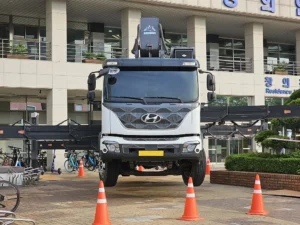The U.S. Department of Transportation has issued a final rule requiring all new heavy-duty trucks over 10,000 pounds to be equipped with Automatic Emergency Braking (AEB) systems by 2026. The move aims to reduce rear-end crashes and improve highway safety across the country.
The Federal Motor Carrier Safety Administration (FMCSA) and the National Highway Traffic Safety Administration (NHTSA) jointly released the long-awaited regulation in October 2025, confirming that all newly manufactured trucks in Classes 3 through 8 must include Automatic Emergency Braking (AEB) starting in September 2026.
The decision, part of the DOT’s Road to Zero initiative, comes as the agency seeks to curb the more than 5,000 annual fatalities involving large commercial vehicles in the United States.
A technology long standard in cars, now coming to trucks
AEB technology uses radar, cameras, and sensors to detect obstacles ahead and automatically apply the brakes if the driver does not respond quickly enough. While most passenger cars now come equipped with AEB, its use in heavy commercial trucks has remained optional or limited to high-end fleets.
According to the final rule published in the Federal Register, all Class 7 and 8 trucks (over 26,000 pounds) and Class 3–6 vehicles (over 10,000 pounds) will be required to include factory-installed AEB systems. Manufacturers will have up to 24 months to update their production lines.
The FMCSA estimates that the rule could prevent up to 60% of rear-end collisions involving heavy trucks and reduce the severity of others by nearly a quarter. Studies from the University of Michigan Transportation Research Institute back these projections, showing a strong correlation between AEB-equipped fleets and fewer highway crashes.
Industry reaction: support with caution
Industry associations such as the American Trucking Associations (ATA) and the Owner-Operator Independent Drivers Association (OOIDA) welcomed the safety goal but raised concerns about the financial and technical burden for small carriers.
“We support technologies that save lives, but they must be affordable and reliable for independent operators and small fleets,” said Todd Spencer, president of OOIDA.
The ATA urged the Department of Transportation to ensure a gradual rollout and to consider tax incentives or rebates to offset installation costs, estimated between $2,500 and $5,000 per truck depending on the make and model.
With nearly 90% of U.S. carriers operating fewer than 10 trucks, smaller companies warn that the regulation could drive up total acquisition costs just as freight rates remain soft and interest rates high.

Government stance: safety first, savings to follow
DOT officials argue that the benefits of the rule far outweigh the costs. The agency projects it will prevent roughly 20,000 crashes and save more than 150 lives per year, generating an estimated $640 million in annual savings from reduced medical expenses, property damage, and downtime.
“Automatic emergency braking is a proven technology that can save lives immediately, especially on interstate highways where a single second of distraction can be fatal,” said Deputy Secretary Polly Trottenberg.
The rule also seeks to standardize safety requirements nationwide. Until now, only a handful of states required advanced driver-assistance systems (ADAS) for commercial fleets, creating inconsistencies across jurisdictions.
Technical challenges and limited exemptions
One of the main implementation hurdles will be compatibility with existing braking systems, particularly older air-brake configurations. The FMCSA has outlined provisions for limited exemptions, covering specialized equipment such as tankers, heavy haulers, and customized vocational vehicles.
Manufacturers must ensure the AEB software integrates with other safety systems — including electronic stability control and lane-departure warning — and must store braking event data for post-crash analysis and regulatory review.
Training and transition ahead
Beyond installation, the rule requires fleets to train drivers and technicians on AEB operation, maintenance, and troubleshooting. CDL training schools will also need to update curricula before September 2026 to include modules on automated braking and advanced safety technologies.
According to FMCSA projections, the investment will pay for itself within three years, thanks to lower crash rates and reduced insurance premiums for compliant fleets.
A global trend gaining traction
With this rule, the United States joins countries such as Japan, Canada, and members of the European Union, where AEB is already mandatory for commercial vehicles. The U.S. implementation, however, provides a longer transition period to accommodate the nation’s larger and more diverse truck fleet.
The DOT’s message is clear: the technology is available, the data is conclusive, and it’s time for the industry to act. As the agency put it, “No truck should fail to stop when a life is on the line.”

Truck drivers are at high risk of developing diabetes
About 11% of the adult population meets the criteria for prediabetes, and there is a particular group at high risk: truck drivers. Diabetes rates in

Starting in trucking: required permits, registrations, and compliance
Are you a new carrier? This is what you need to know about permits, registration, and compliance. The trucking industry can be quite challenging for

Alberta Clipper Brings an Early Polar Blast: A Critical Alert for Drivers
The Alberta Clipper is sweeping across the country with fast-moving Arctic air, sharp temperature drops, and dangerous road conditions that demand heightened attention from all professional drivers.

American manufacturers trigger truck “dumping” investigation
Foreign trailer manufacturers under investigation for alleged “dumping” in the U.S. The U.S. truck market is at the center of a trade dispute. After domestic

ATRI Warns: Litigation Is Rising Across the U.S. Trucking Industry
A new report from the American Transportation Research Institute (ATRI) reveals how escalating litigation, higher legal costs, and mounting insurance pressures are reshaping the U.S. trucking industry. The findings mark a critical moment for motor carriers, insurers, and logistics stakeholders who must understand the changing legal environment — and the increasingly strategic role of strong insurance partnerships.

FMCSA says no to hours-of-service exemptions
FMCSA rejects two requests for exemptions to hours-of-service rules for commercial drivers. The Federal Motor Carrier Safety Administration (FMCSA) has denied two exemption requests related
